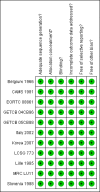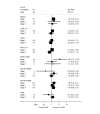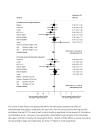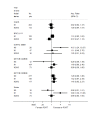Postoperative radiotherapy for non-small cell lung cancer
- PMID: 27684386
- PMCID: PMC6457851
- DOI: 10.1002/14651858.CD002142.pub3
Postoperative radiotherapy for non-small cell lung cancer
Update in
-
Postoperative radiotherapy for non-small cell lung cancer.Cochrane Database Syst Rev. 2016 Oct 11;10(10):CD002142. doi: 10.1002/14651858.CD002142.pub4. Cochrane Database Syst Rev. 2016. PMID: 27727451 Free PMC article. Review.
Abstract
Background: The role of postoperative radiotherapy (PORT) in the treatment of patients with completely resected non-small cell lung cancer (NSCLC) was not clear. A systematic review and individual participant data meta-analysis was undertaken to evaluate available evidence from randomised controlled trials (RCTs). These results were first published in Lung Cancer in 2013.
Objectives: To evaluate the effects of PORT on survival and recurrence in patients with completely resected NSCLC. To investigate whether predefined patient subgroups benefit more or less from PORT.
Search methods: We supplemented MEDLINE and CANCERLIT searches (1965 to 8 July 2016) with information from trial registers, handsearching of relevant meeting proceedings and discussion with trialists and organisations.
Selection criteria: We included trials of surgery versus surgery plus radiotherapy, provided they randomised participants with NSCLC using a method that precluded prior knowledge of treatment assignment.
Data collection and analysis: We carried out a quantitative meta-analysis using updated information from individual participants from all randomised trials. We sought data on all participants from those responsible for the trial. We obtained updated individual participant data (IPD) on survival and date of last follow-up, as well as details on treatment allocation, date of randomisation, age, sex, histological cell type, stage, nodal status and performance status. To avoid potential bias, we requested information on all randomised participants, including those excluded from investigators' original analyses. We conducted all analyses on intention-to-treat on the endpoint of survival.
Main results: We identified 14 trials evaluating surgery versus surgery plus radiotherapy. Individual participant data were available for 11 of these trials, and our analyses are based on 2343 participants (1511 deaths). Results show a significant adverse effect of PORT on survival, with a hazard ratio of 1.18, or an 18% relative increase in risk of death. This is equivalent to an absolute detriment of 5% at two years (95% confidence interval (CI) 2% to 9%), reducing overall survival from 58% to 53%. Subgroup analyses showed no differences in effects of PORT by any participant subgroup covariate.We did not undertake analysis of the effects of PORT on quality of life and adverse events. Investigators did not routinely collect quality of life information during these trials, and it was unlikely that any benefit of PORT would offset the observed survival disadvantage. We considered risk of bias in the included trials to be low.
Authors' conclusions: Results from 11 trials and 2343 participants show that PORT is detrimental to those with completely resected non-small cell lung cancer and should not be used in the routine treatment of such patients. Results of ongoing RCTs will clarify the effects of modern radiotherapy in patients with N2 tumours.
Conflict of interest statement
None known.
Figures














Similar articles
-
Postoperative radiotherapy for non-small cell lung cancer.Cochrane Database Syst Rev. 2016 Oct 11;10(10):CD002142. doi: 10.1002/14651858.CD002142.pub4. Cochrane Database Syst Rev. 2016. PMID: 27727451 Free PMC article. Review.
-
Adjuvant chemotherapy for resected early-stage non-small cell lung cancer.Cochrane Database Syst Rev. 2015 Mar 2;2015(3):CD011430. doi: 10.1002/14651858.CD011430. Cochrane Database Syst Rev. 2015. PMID: 25730344 Free PMC article. Review.
-
Postoperative radiotherapy for non-small cell lung cancer.Cochrane Database Syst Rev. 2003;(1):CD002142. doi: 10.1002/14651858.CD002142. Cochrane Database Syst Rev. 2003. Update in: Cochrane Database Syst Rev. 2005 Apr 18;(2):CD002142. doi: 10.1002/14651858.CD002142.pub2. PMID: 12535431 Updated. Review.
-
Postoperative radiotherapy for non-small cell lung cancer.Cochrane Database Syst Rev. 2000;(2):CD002142. doi: 10.1002/14651858.CD002142. Cochrane Database Syst Rev. 2000. Update in: Cochrane Database Syst Rev. 2003;(1):CD002142. doi: 10.1002/14651858.CD002142. PMID: 10796868 Updated. Review.
-
Postoperative radiotherapy for non-small cell lung cancer.Cochrane Database Syst Rev. 2005 Apr 18;(2):CD002142. doi: 10.1002/14651858.CD002142.pub2. Cochrane Database Syst Rev. 2005. PMID: 15846628 Review.
Cited by
-
Prognostic and predictive biomarkers post curative intent therapy.Ann Transl Med. 2017 Sep;5(18):374. doi: 10.21037/atm.2017.07.34. Ann Transl Med. 2017. PMID: 29057234 Free PMC article. Review.
-
Postoperative radiotherapy in pIIIA-N2 non-small cell lung cancer after complete resection and adjuvant chemotherapy: A meta-analysis.Medicine (Baltimore). 2022 Jul 15;101(28):e29550. doi: 10.1097/MD.0000000000029550. Medicine (Baltimore). 2022. PMID: 35839025 Free PMC article.
-
Tri-modality treatment in N2 stage IIIa non-small cell lung cancer: proper sequence remains unknown.J Thorac Dis. 2018 Apr;10(Suppl 9):S1096-S1098. doi: 10.21037/jtd.2018.03.69. J Thorac Dis. 2018. PMID: 29849225 Free PMC article. No abstract available.
-
The Change Trend of Cause of Death in Patients With Stage I Non-Small Cell Lung Cancer After Surgery in US: A Long-Term Follow-Up Study Based on SEER Database.Cancer Control. 2020 Jan-Dec;27(1):1073274820954461. doi: 10.1177/1073274820954461. Cancer Control. 2020. PMID: 33070629 Free PMC article.
-
Multidisciplinary consensus statement on the clinical management of patients with stage III non-small cell lung cancer.Clin Transl Oncol. 2020 Jan;22(1):21-36. doi: 10.1007/s12094-019-02134-7. Epub 2019 Jun 6. Clin Transl Oncol. 2020. PMID: 31172444
References
References to studies included in this review
-
- Houtte P, Rocmans P, Smets P, Goffin JC, Lustman‐Marecal J, Vanderhoeft P, et al. Postoperative radiation therapy in lung cancer: a controlled trial after resection of curative design. International Journal of Radiation, Oncology, Biology and Physics 1980;6:983‐6. - PubMed
-
- Feng QF, Wang M, Wang LJ, Yang ZY, Zhang YG, Zhang DW, et al. A study of postoperative radiotherapy in patients with non‐small cell lung cancer: a randomized trial. International Journal of Radiation Oncology, Biology, Physics 2000;47(4):925‐9. - PubMed
-
- EORTC 08861(unpublished). Phase III randomised trial of adjuvant radiotherapy vs no adjuvant therapy with completely resected non‐small cell lung cancer.
-
- Dautzenberg B, Arriagada R, Chammard AB, Jarema A, Mezzetti M, Mattson K, et al. for the Groupe d'Etude et de Traitement des Cancers Bronchiques. A controlled study of postoperative radiotherapy for patients with completely resected nonsmall cell lung carcinoma. Cancer1999; Vol. 86, issue 2:265‐273. - PubMed
-
- Dautzenberg B, Arriagada R, Chammard AB, Jarema A, Mezzetti M, Mattson K, et al. for the Groupe d'Etude et de Traitement des Cancer Bronchiques. A controlled study of postoperative radiotherapy for patients with completely resected nonsmall cell lung carcinoma. Cancer 1999;86(2):265‐73; Vol. 86, issue 2:265‐273. - PubMed
References to studies excluded from this review
-
- Mayer R, Smolle‐Juettner F‐M, Szolar D, Stuecklschweiger GF, Quehenberger F, Friehs G, et al. Postoperative radiotherapy in radically resected non‐small cell lung cancer. Chest 1997;112:954‐9. - PubMed
-
- Dymek P, Kowalska T, Reinfuss M, Walasek T, Zareba‐Szlubowska M, Mitus J, et al. The efficacy of adjuvant thoracic radiation therapy in NSCLC patients with ipsilateral mediastinal/hilar lymph node involvement [Ocena skutecznosci pooperacyjnej teleradioterapii chorych na NDRP zoperowanych miejscowo doszczetnie z obecnoscia przerzutow w usunietych wezlach chlonnych srodpiersia albo wneki (kontrolowane doswiadczenie kliniczne)]. Pneumonol Alergol Pol 2003;71(11‐12):496‐503. - PubMed
-
- Lung Cancer Study Group (Unpublished). Phase III randomised study of post‐op radiotherapy vs no radiotherapy following resection of non‐small cell lung cancer.
References to ongoing studies
-
- LUNG ART‐IGR 2006/1202 (ongoing). Phase III study comparing post‐operative conformal radiotherapy to no post‐operative radiotherapy in patients with completely resected non‐small cell lung cancer and mediastinal N2 involvement. NCT00410683.
Additional references
-
- American Cancer Society. Cancer Facts and Figures 2007. Atlanta: American Cancer Society, 2007.
-
- Billiet C, Dealuwe H, Peeters S, Vansteenkiste J, Dooms C, Haustermans K, et al. Corrigendum to "Modern post‐operative radiotherapy for stage III non‐small cell lung cancer may improve local control and survival: A meta‐analysis". Radiotherapy and Oncology 2014;113(2):300‐1. - PubMed
-
- Datta D, Lahiri B. Preoperative evaluation of patients undergoing lung resection surgery. Chest 2003;123:2096‐103. - PubMed
-
- Fisher DJ, Copas AJ, Tierney JF, Parmar MKB. A critical review of methods for the assessment of patient‐level interactions in individual patient data (IPD) meta‐analysis of randomised trials, and guidance for practitioners. Journal of Clinical Epidemiology 2011;64:949‐67. - PubMed
References to other published versions of this review
-
- PORT Meta‐analysis Trialists Group. Postoperative radiotherapy in non‐small‐cell lung cancer: systematic review and meta‐analysis of individual patient data from nine randomised controlled trials. Lancet 1998;352:257‐63. - PubMed
-
- Burdett S, Stewart L, on behalf of the PORT Meta‐analysis Trialist Group. Postoperative radiotherapy in non‐small cell lung cancer: update of an individual patient data meta‐analysis. Lung Cancer 2005;47(1):81‐3. - PubMed
-
- Burdett S, Rydzewska L, Tierney JF, Fisher DJ. A closer look at the effects of postoperative radiotherapy by stage and nodal status: updated results of an individual participant data meta‐analysis in non‐small‐cell lung cancer. Lung Cancer 2013;80:350‐2. - PubMed
Publication types
LinkOut - more resources
Full Text Sources
Other Literature Sources

